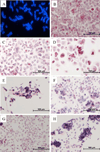Integration of high-risk human papillomavirus into cellular cancer-related genes in head and neck cancer cell lines
- PMID: 28236344
- PMCID: PMC5392184
- DOI: 10.1002/hed.24729
Integration of high-risk human papillomavirus into cellular cancer-related genes in head and neck cancer cell lines
Abstract
Background: Human papillomavirus (HPV)-positive oropharyngeal cancer is generally associated with excellent response to therapy, but some HPV-positive tumors progress despite aggressive therapy. The purpose of this study was to evaluate viral oncogene expression and viral integration sites in HPV16- and HPV18-positive squamous cell carcinoma lines.
Methods: E6/E7 alternate transcripts were assessed by reverse transcriptase-polymerase chain reaction (RT-PCR). Detection of integrated papillomavirus sequences (DIPS-PCR) and sequencing identified viral insertion sites and affected host genes. Cellular gene expression was assessed across viral integration sites.
Results: All HPV-positive cell lines expressed alternate HPVE6/E7 splicing indicative of active viral oncogenesis. HPV integration occurred within cancer-related genes TP63, DCC, JAK1, TERT, ATR, ETV6, PGR, PTPRN2, and TMEM237 in 8 head and neck squamous cell carcinoma (HNSCC) lines but UM-SCC-105 and UM-GCC-1 had only intergenic integration.
Conclusion: HPV integration into cancer-related genes occurred in 7 of 9 HPV-positive cell lines and of these 6 were from tumors that progressed. HPV integration into cancer-related genes may be a secondary carcinogenic driver in HPV-driven tumors. © 2017 Wiley Periodicals, Inc. Head Neck 39: 840-852, 2017.
Keywords: cancer; head and neck squamous cell carcinoma (HNSCC); human papillomavirus (HPV); integration; oropharynx.
© 2017 Wiley Periodicals, Inc.
Conflict of interest statement
The authors disclose no potential conflicts of interest.
Figures





References
-
- Gillison ML. Human papillomavirus-associated head and neck cancer is a distinct epidemiologic, clinical, and molecular entity. Semin Oncol. 2004;31:744–754. - PubMed
-
- Gillison ML, Koch WM, Capone RB, et al. Evidence for a causal association between human papillomavirus and a subset of head and neck cancers. J Natl Cancer Inst. 2000;92:709–720. - PubMed
-
- Gillison ML, D’Souza G, Westra W, et al. Distinct risk factor profiles for human papillomavirus type 16-positive and human papillomavirus type 16-negative head and neck cancers. J Natl Cancer Inst. 2008;100:407–420. - PubMed
Publication types
MeSH terms
Substances
Grants and funding
LinkOut - more resources
Full Text Sources
Other Literature Sources
Medical
Research Materials
Miscellaneous

